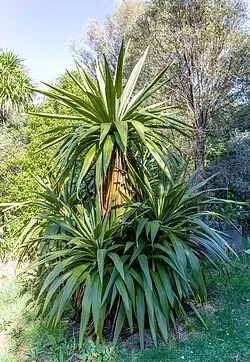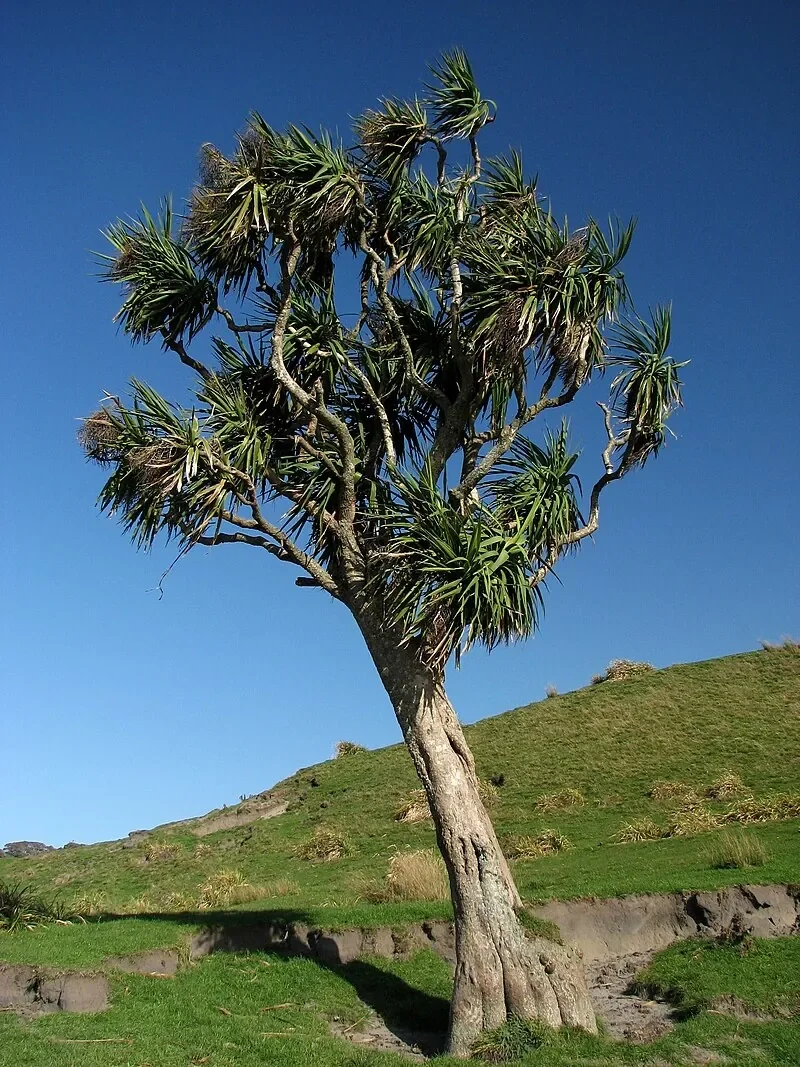
Mountain Cabbage Tree
Cordyline indivisa
Introduction
Introduction Overview
Cordyline indivisa , also known as the mountain cabbage tree, is a distinctive and iconic New Zealand plant with broad blue-green leaves and tall flowering spikes. It is valued for its resilience and cultural significance. native trees .
Related native plants include Cordyline australis , Phormium tenax , Agathis australis and other native species.

Plant Description
Botanical Features
Cordyline indivisa , commonly known as Mountain Cabbage Tree or Toi, is a monocot tree endemic to New Zealand. It is a striking ornamental plant that can grow up to 8 meters tall with a stout trunk, typically unbranched or sparingly branched. Its most distinctive feature is its very broad, blue-grey, sword-shaped leaves, which are 1-2 meters long and 10-30 centimeters wide. These tough, glossy leaves often have a reddish, orange-red, or golden midrib and can droop with age. It produces small, fragrant greenish-white to purplish-brown flowers in drooping panicles, followed by small, globose, bluish to dark blue fruits. This species thrives in cool, damp soils and semi-shade, preferring moist, fertile, organically rich, well-drained conditions.
Quick Facts
Key Features
| Scientific Name | Cordyline Indivisa |
|---|---|
| Height | Up to 8 m (26 ft) |
| Spread | 2-4 m (broad crown) |
| Water Needs | High; prefers consistently moist soil |
| Light | Full sun to part shade |
| Frost Tolerance | Moderate (tolerates light to moderate frost, protect from severe frost) |
| Salt Tolerance | Low (not tolerant of coastal salt) |
| Growth Rate | Moderate |
| Lifespan | Many decades (long-lived) |
Climate Best Suited to
Thrives in cool, moist conditions typical of mountain forests. Prefers temperatures between 5°C and 18°C. Tolerates light frosts and high humidity.
Regional Suitability
| City | Suitability |
|---|---|
| Whangārei | Ideal |
| Auckland | Ideal |
| Hamilton | Ideal |
| Tauranga | Ideal |
| Rotorua | Ideal |
| Gisborne | Ideal |
| New Plymouth | Ideal |
| Napier | Ideal |
| Whanganui | Ideal |
| Palmerston North | Ideal |
| Wellington | Ideal |
| Nelson | Ideal |
| Christchurch | Ideal |
| Dunedin | Ideal |
| Invercargill | Ideal |
Natural Habitat
Natural Habitat Overview
Cordyline is naturally found in specific habitats throughout New Zealand. Understanding its natural environment helps in providing appropriate growing conditions in cultivation.
Plant Conservation
Cordyline indivisa , also known as the mountain cabbage tree or t ōī, is classified as "Not Threatened" in its native New Zealand. While generally widespread and common, particularly in the montane forests and subalpine shrublands of the North and South Islands, some northern populations have experienced declines due to browsing by goats and livestock. It is presumed extinct on Te Moehau due to these factors. There have also been instances of "Sudden Decline" affecting some specimens in cultivation and in the wild, though it's not definitively clear if this species is susceptible to the syndrome.
Soil
Moist, well-draining, rich in organic matter.
Light
Partial shade to dappled sunlight.
Water
Consistent moisture , avoid drought.
Shrubs benefit from regular pruning to maintain shape and encourage bushiness. They respond well to organic mulches.
Planting Guide
Planting Guide Overview
- Choose a cool, moist, sheltered site with well-drained soil.
- Dig a hole twice the width of the root ball.
- Place the plant at the same depth as in the pot.
- Backfill with soil and water thoroughly.
- Mulch to retain moisture and suppress weeds.
Ecological Role
Wildlife Interactions
Cordyline plays an important ecological role in New Zealand's native ecosystems. It provides habitat and food for native wildlife and contributes to ecosystem health and biodiversity.
Uses and Significance
Traditional Uses
- Leaves used for weaving and textiles by Māori.
- Roots occasionally eaten after cooking.
The Mountain Cabbage Tree holds significant cultural value for Māori, who traditionally utilized its leaves for practical purposes and its roots as a food source.
Landscaping Uses
Landscaping Uses Overview
Cordyline is highly valued in landscaping for its aesthetic appeal and practical benefits. It can be used in various garden styles and landscape applications.
Seasonal Care
Spring
- New growth emerges; apply mulch to retain moisture.
- Check for frost damage and prune if needed.
Summer
- Water regularly during dry spells.
- Monitor for pests and diseases.
Autumn
- Remove dead leaves and debris.
- Prepare for cooler temperatures with extra mulch.
Winter
- Minimal care required; protect from severe frost if possible.
- Plan new plantings for spring.
Pruning
Pruning Techniques
Remove dead or damaged leaves as needed. Prune flower stalks after blooming to maintain appearance. Minimal pruning is required for healthy plants.
How to Grow Mountain Cabbage Tree
The Mountain Cabbage Tree is a striking and distinctive native plant, prized for its bold, broad leaves and architectural form. Unlike its more common relative, Cordyline australis , it typically remains unbranched or sparsely branched, forming a single, stout trunk topped with a dense crown of leaves. It thrives in cooler, moist, and sheltered environments, often found in higher altitude forests. While it is a magnificent specimen plant, it requires specific conditions to flourish, making it a plant for the dedicated gardener.
From Seed
Mountain Cabbage Tree can be grown from seed, though germination can be slow and erratic. Collect fresh seeds from ripe berries in autumn. Clean the seeds thoroughly to remove any pulp and sow them in a well-draining seed-raising mix. Lightly cover the seeds with a thin layer of mix. Maintain consistent moisture and a cool, stable temperature, ideally around 15-20°C. Germination can take several weeks to several months. Once seedlings are large enough to handle, prick them out and pot them into individual containers. Protect young plants from frost and strong winds, and gradually accustom them to outdoor conditions before planting into their final, sheltered position.
From Cuttings
Propagation from stem cuttings is possible but can be more challenging than with other Cordyline species. Take stem sections, about 6-12 inches long, from healthy, mature stems in late spring or early summer. Ensure each cutting has at least one node. Remove any leaves from the lower half of the cutting and, if desired, dip the cut end in a rooting hormone. Insert the cuttings into a well-draining potting mix, ensuring good contact with the medium. Keep the cuttings moist and in a warm, sheltered location with indirect light and high humidity. Rooting can be slow and success rates can vary. Once rooted, the new plants can be potted on and grown in a sheltered environment until they are ready for planting.
From Suckers
Established Mountain Cabbage Trees often produce suckers or offsets from the base of the main trunk. These can be carefully detached and grown into new plants. Use a sharp knife or spade to separate the suckers from the parent plant, ensuring each sucker has some roots attached. Plant the suckers directly into a well-draining potting mix or into their final garden position. Water thoroughly after planting and keep consistently moist until established. This method is generally more successful and faster than seed propagation for mature plants.
Pests and Diseases
Common Pests
Cordyline is generally resistant to most pests due to its native adaptations. However, it may occasionally be affected by common garden pests such as aphids or scale insects.
Disease Prevention
To prevent diseases, ensure good air circulation around Cordyline and avoid overwatering. Remove any diseased plant material promptly to prevent spread.
Cultural Significance
Cordyline indivisa , also known as the mountain cabbage tree or t ōī in Māori, holds significant cultural importance, particularly for the Māori people of New Zealand.
Traditional Uses:
- Weaving and Fibre: The broad leaves of Cordyline indivisa were highly valued in traditional Māori weaving. They were used to create durable rain capes, which were considered superior to those made from other Cordyline species due to the plant's wider leaves. The leaves also provided a strong fiber for making paper, twine, cloth, baskets, and thatching. The midrib of the leaves was sometimes dyed red and used for plaiting or patterning on items like poi.
- Food Source: The plant served as a food source. The pith of the trunk was dried and steamed to make porridge or a sweet drink, and the root and stems are rich in fructose. Young shoots could be eaten as a cabbage substitute, and the fruit was also consumed. While the roots of Cordyline indivisa were sometimes eaten, they were not as commonly appreciated as other parts of the plant.
- Medicinal Uses: While not as extensively documented as its uses for food and fiber, some Cordyline species, including Cordyline indivisa , have been used in traditional medicine for various ailments. The young leaves were used for their astringent, antimicrobial, antidiarrhoeal, and wound-healing properties, assisting with issues like diarrhea, colic, stomachache, and external sores or cuts.
Spiritual Significance:
Beyond its practical applications, Cordyline species, including C. indivisa, also held spiritual significance in Māori tradition. The plant continues to be important in contemporary Māori culture and environmental stewardship.
Bonus Tip
Expert Growing Advice
While the Mountain Cabbage Tree ( Cordyline indivisa ) shares a name with its more common relative, the Cabbage Tree ( Cordyline australis ), it has one crucial difference in its care requirements: it cannot tolerate dry conditions. Unlike the hardy and drought-tolerant C. australis , the Mountain Cabbage Tree thrives in cool, moist, and sheltered environments, similar to its natural habitat in mountain forests. To keep this stunning plant happy, ensure its soil remains consistently moist, especially during warmer months. A thick layer of mulch will help retain moisture and keep the roots cool. If you can provide these conditions, you'll be rewarded with the magnificent sight of its broad, blue-green leaves, which are among the most impressive in the New Zealand flora.







